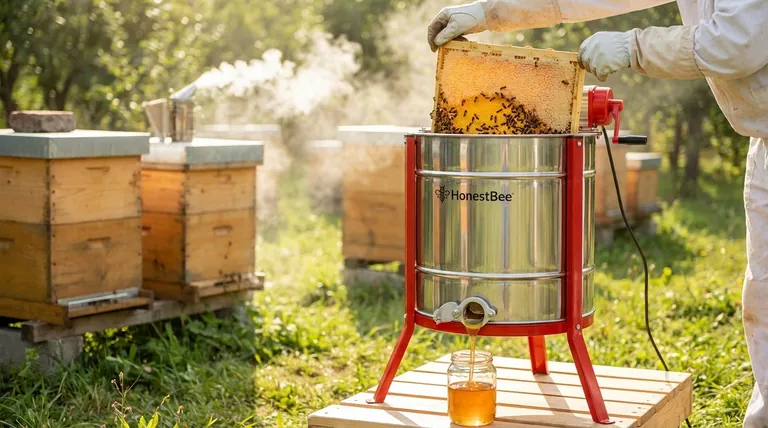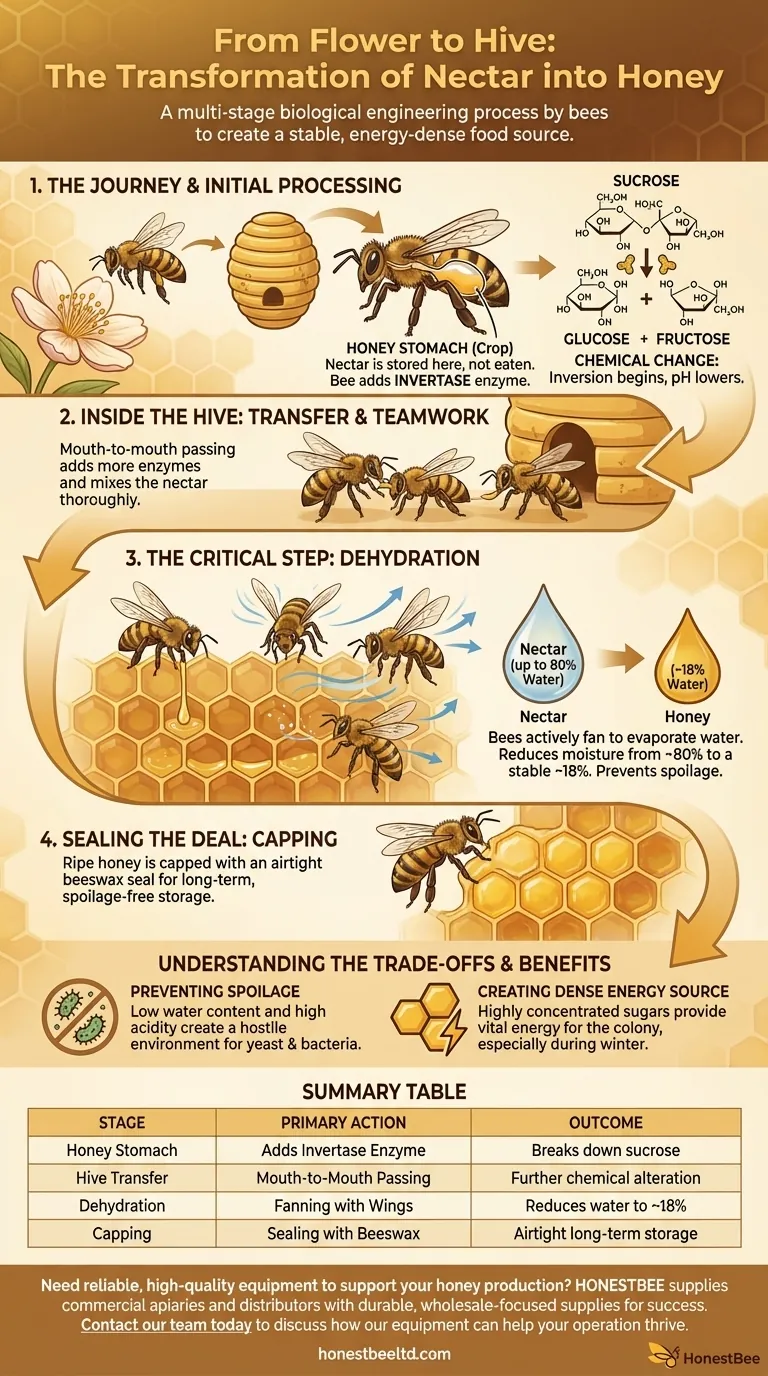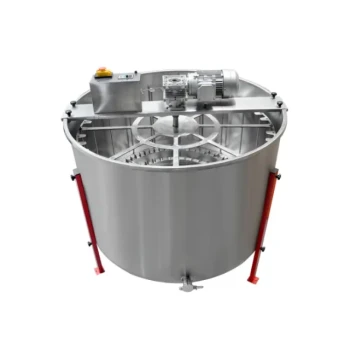Once a bee extracts nectar from a flower, it immediately begins a deliberate, multi-stage process to transform it into honey. The nectar is ingested and stored in a specialized "honey stomach," where the bee adds specific enzymes to begin breaking down its complex sugars and altering its chemical composition. This is the first critical step in creating the energy-dense, stable food source the colony needs to survive.
Turning nectar into honey is not simple storage; it is an active manufacturing process. Bees fundamentally change the nectar's chemistry with enzymes and then physically alter it through intensive dehydration to create a product that can last for years.

The Journey from Flower to Hive: Initial Processing
The transformation begins the moment the forager bee leaves the flower. The process is efficient and involves specialized anatomy and chemistry.
The Honey Stomach: A Specialized Tank
A forager bee does not "eat" the nectar for immediate energy. Instead, it stores the nectar in a separate organ known as the crop, or more commonly, the honey stomach.
This organ is essentially a biological transport tank. A valve prevents the nectar from passing into the bee's true digestive stomach, ensuring the raw material for honey remains pure.
The First Chemical Change: Adding Enzymes
While the nectar is in the honey stomach, the bee secretes enzymes from its salivary glands and mixes them in. The most important of these is invertase.
The job of invertase is to break down sucrose, the complex sugar that makes up most nectar, into two simpler sugars: glucose and fructose. This process, called inversion, also begins to lower the nectar's pH, making it more acidic.
Inside the Hive: The Transformation to Honey
When the forager bee returns to the hive, it does not deposit the nectar directly into a cell. Instead, it hands off its cargo to "house bees" who continue the process.
Transfer and Teamwork
The forager bee regurgitates the enzyme-treated nectar, passing it mouth-to-mouth to a house bee. This process may be repeated several times between different house bees.
Each transfer adds more enzymes to the mixture, further breaking down the sugars and ensuring the process is well underway before the nectar is ever placed in the honeycomb.
The Critical Step: Dehydration
Nectar can be up to 80% water, which would quickly spoil. To create stable honey, the bees must reduce the water content to around 18%.
This is achieved through a two-part dehydration process. First, the house bee deposits the nectar as a thin film on the upper wall of a honeycomb cell. The high temperature and air circulation in the hive begin to passively evaporate water.
Next, bees actively fan the honeycomb with their wings, creating a strong, steady airflow that dramatically accelerates the evaporation. This is the most critical step in creating the thick, viscous consistency of honey.
Sealing the Deal: Capping the Honeycomb
Once the water content is sufficiently low, the nectar is officially considered "ripe" honey. To preserve it for long-term storage, the bees seal the honeycomb cell with a fresh cap of beeswax.
This airtight seal protects the honey from moisture and contaminants, allowing it to be stored almost indefinitely.
Understanding the Trade-offs of This Process
This complex transformation is not arbitrary. Every step is a solution to a critical survival problem for the honeybee colony.
Preventing Spoilage
The two key changes—the addition of enzymes and dehydration—are what make honey one of the most spoil-resistant foods in nature.
The low water content (~18%) creates a high osmotic pressure, which draws water out of and kills any yeast or bacteria that land in it. The low pH (high acidity) further creates a hostile environment for microbes.
Creating a Dense Energy Source
By removing the water, bees concentrate the nectar's sugars into a highly dense and efficient energy source. This is vital for surviving the long winter months or periods when there are no flowers to forage.
Without this process, the colony would be unable to store enough food to sustain its population.
Making the Right Choice for Understanding
The creation of honey is a perfect example of biological engineering, where chemistry and teamwork combine to solve a fundamental need.
- If your primary focus is the biology: The key is the bee's specialized honey stomach and the addition of the invertase enzyme, which fundamentally alters the nectar's chemical structure.
- If your primary focus is the final product (honey): The most crucial factor is dehydration, where bees reduce the water content to below 18%, making honey a shelf-stable and energy-dense food.
Ultimately, this intricate process transforms a perishable flower secretion into a stable, life-sustaining resource for the entire colony.
Summary Table:
| Key Stage | Primary Action | Outcome |
|---|---|---|
| Honey Stomach | Bee adds invertase enzyme | Breaks down sucrose into glucose & fructose |
| Hive Transfer | Mouth-to-mouth passing between bees | Further enzyme mixing and chemical alteration |
| Dehydration | Fanning wings to evaporate water | Reduces water content from ~80% to ~18% |
| Capping | Sealing cell with beeswax | Creates an airtight seal for long-term storage |
Need reliable, high-quality equipment to support your honey production?
The intricate process of turning nectar into honey requires a healthy, productive colony. HONESTBEE supplies commercial apiaries and beekeeping equipment distributors with the durable, wholesale-focused supplies needed for success—from hive components to extraction tools.
Contact our team today to discuss how our equipment can help your operation thrive.
Visual Guide

Related Products
- Electric 8 Frame Honey Spinner Extractor Equipment for Beekeeping
- HONESTBEE 3-Frame Manual Acrylic Honey Extractor
- HONESTBEE 72 Frame Industrial Electric Honey Extractor for Beekeeping
- Commercial Electric 12 Frame Honey Extractor Spinner Motorized Honey Extractor
- electric honey extractor honey centrifuge 3 frame honey extractor stainless steel honey frame extractor
People Also Ask
- What equipment is needed for extracting honey? A Complete Guide for Every Beekeeper
- How long should you spin honey? Master the Art of Efficient, Damage-Free Extraction
- What machines are needed in beekeeping besides basic tools? Scale Your Honey Harvest Efficiently
- How long should you spin honey for? Master the Art of Efficient, Safe Extraction
- Why is cleaning a honey extractor important in beekeeping? Protect Your Honey Quality & Equipment



















